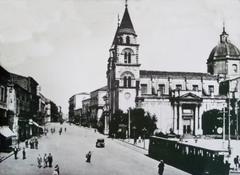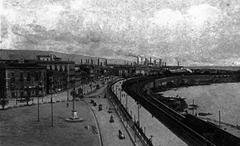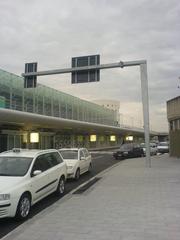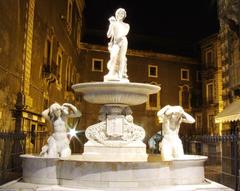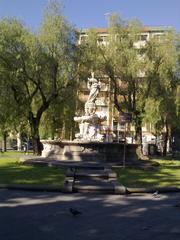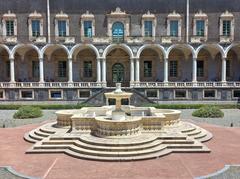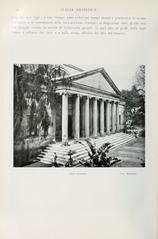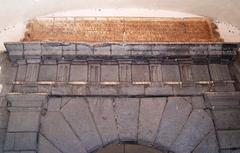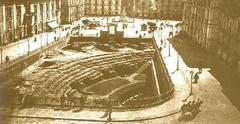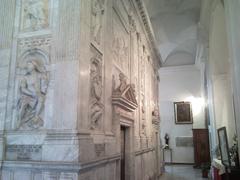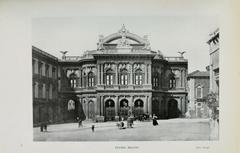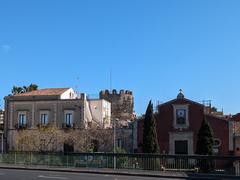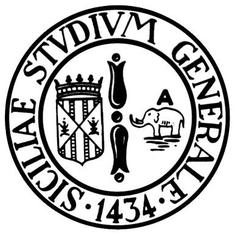
Catania Astrophysical Observatory Visiting Hours, Tickets, and Travel Guide
Date: 04/07/2025
Introduction
The Catania Astrophysical Observatory (Osservatorio Astrofisico di Catania, OACT) stands as one of Sicily’s premier scientific institutions. Since its foundation in the late 19th century, it has been at the forefront of astronomical research and public outreach, making it a must-visit site for astronomy enthusiasts, students, and travelers seeking to experience Sicily’s scientific and cultural heritage. This guide offers comprehensive details on the observatory’s history, significance, visiting hours, ticketing, accessibility, travel tips, and how to make the most of your visit (beniculturali.inaf.it; oact.inaf.it).
Table of Contents
- Introduction
- Historical Overview
- Visiting the Observatory
- Notable Milestones
- Visitor Experience: What to Expect
- Special Events and Educational Programs
- Practical Visitor Tips
- Frequently Asked Questions (FAQ)
- Booking and Contact Information
- Conclusion and Further Resources
Historical Overview
Origins and Early Foundations
The observatory’s origins date back to the late 19th century, when astronomer Pietro Tacchini envisioned leveraging Sicily’s climate and geography for astronomical research. In 1880, the Bellini Observatory was established atop Mount Etna, combining meteorological and astronomical studies and initially affiliated with the University of Catania’s Institute of Vulcanology. However, the extreme altitude and challenging weather conditions limited operations, prompting a move to the city of Catania (Springer; beniculturali.inaf.it).
Relocation and Growth
In 1885, the observatory was relocated near the Benedictine Monastery of San Nicolò l’Arena, establishing a more accessible and sustainable environment for research. This shift, formalized by royal decree, laid the groundwork for its enduring partnership with the University of Catania. Under the directorship of Annibale Riccò, the observatory’s scientific ambitions and international collaborations flourished (oact.inaf.it).
Scientific Contributions and International Collaboration
The observatory quickly gained recognition by participating in the Carte du Ciel project—a monumental global effort to photograph and chart the night sky. It also became a key contributor of daily solar observations, providing valuable data on sunspots and prominences to the international scientific community (beniculturali.inaf.it).
Expansion and Modernization
By the 1960s, increasing urbanization and light pollution in Catania led to the establishment of two new facilities: a modern headquarters on the university campus and the Serra La Nave observing station on Mount Etna. The latter, equipped with a 91-cm classical Cassegrain telescope, continues to support advanced optical and photometric research in pristine conditions (oato.inaf.it).
Integration into INAF and Contemporary Role
Since 2002, the observatory has operated as part of Italy’s National Institute for Astrophysics (INAF), ensuring both scientific autonomy and access to cutting-edge research infrastructure. Today, it plays a vital role in national and international projects, such as the Solar Orbiter mission, and serves as a dynamic hub for education, public engagement, and scientific discovery (aanda.org; oact.inaf.it).
Visiting the Observatory
Visiting Hours
- Main Site (Via Santa Sofia 78, Catania): Open by appointment, typically Monday to Friday, 9:00 AM to 5:00 PM. Weekend visits may be arranged for special events or public programs.
- Serra La Nave Station (Mount Etna): Accessible by appointment, primarily from June to October due to weather conditions.
Always confirm current hours on the official website before planning your visit.
Tickets and Guided Tours
- Admission: Free for educational groups and school visits. Public events and special programs (e.g., night sky observations) may require a nominal fee (€5–10 per person).
- Guided Tours: Led by astronomers or science communicators, tours last 60–90 minutes and include access to historical and modern instruments, interactive demonstrations, and, weather permitting, solar or night sky observations.
- Booking: Advance booking (at least two weeks ahead) is essential, especially during the academic year or for large groups (official observatory website).
Accessibility and Location
- Address: Via Santa Sofia 78, 95123 Catania, Italy
- Getting There: Easily accessible from Catania’s city center by public bus (routes 432, 449, BRT1), taxi (€15–20 from city center), or car (limited parking on campus).
- Accessibility: The main building is wheelchair accessible, but some historic domes and the Serra La Nave site may have limited access due to stairs or uneven terrain. Notify staff in advance regarding accessibility needs (Catania transport guide).
Travel Tips and Nearby Attractions
- Combine Your Visit: Explore nearby UNESCO sites such as the Benedictine Monastery, Catania’s Baroque city center, and the University Botanical Garden.
- Mount Etna: The Serra La Nave station provides access to panoramic volcanic landscapes and hiking trails.
- Best Time to Visit: Spring and autumn offer mild weather and clear skies, ideal for both daytime and evening events (thecrazytourist.com).
Notable Milestones
- 1880: Bellini Observatory established on Mount Etna.
- 1885: Relocation to the Benedictine Monastery in Catania.
- 1892: Start of daily solar observations.
- 1966: Opening of modern headquarters and Serra La Nave station.
- 1982: Granted administrative autonomy.
- 2002: Integration into INAF.
The archives house invaluable documents and photographs chronicling more than a century of astronomical achievement (beniculturali.inaf.it).
Visitor Experience: What to Expect
- Exhibitions: Historical displays, scientific instruments (including the 19th-century Merz and Zeiss refractors), and multimedia presentations on ongoing research.
- Observing Sessions: Safe solar observations during the day; stargazing events at the Serra La Nave station offer views of planets and deep-sky objects.
- Family-Friendly: Special programs and educational activities for children and students.
- Facilities: Restrooms, vending machines, a small gift shop, and accessible amenities. No on-site café, but nearby university eateries are available.
Special Events and Educational Programs
- Public Outreach: Annual events such as the Science Culture Week and Night of the Stars feature lectures, workshops, and guided observations.
- School Programs: Tailored visits and lab demonstrations aligned with curricula, offered in Italian and English.
- Workshops: Topics include spectroscopy, astrophotography, and current research trends.
- Serra La Nave: Tours of the ASTRI-Horn telescope and participation in international projects like the Cherenkov Telescope Array (go-astronomy.com).
Practical Visitor Tips
- Dress Appropriately: Wear comfortable shoes and bring a jacket for cool evenings, especially at higher elevations.
- Photography: Allowed in most areas, but flash and tripods may be restricted in telescope domes.
- Language: Tours are mainly in Italian; English-speaking guides and materials are available upon request.
- Children: Supervision is required, particularly near scientific equipment.
- COVID-19 and Safety: Check the latest health protocols on the official website before your visit.
Frequently Asked Questions (FAQ)
Q: What are the visiting hours?
A: By appointment, Monday to Friday, 9:00 AM–5:00 PM. Special events may occur on weekends.
Q: Is there an entrance fee?
A: Admission is free for most educational and outreach visits. Some special events may have a fee.
Q: Are guided tours available in English?
A: Yes, upon advance request.
Q: Is the observatory wheelchair accessible?
A: Main building is accessible; some domes and the Serra La Nave site may have limited access.
Q: Can children participate?
A: Yes, with group activities and programs designed for various ages.
Q: How do I book a visit?
A: Contact the outreach office via the official website or email [email protected].
Booking and Contact Information
- Website: oact.inaf.it
- Email: [email protected]
- Phone: +39 095 7332111
- Address: Via Santa Sofia, 78, 95123 Catania, Italy
Conclusion and Further Resources
The Catania Astrophysical Observatory is a beacon of discovery, bridging the past and present of astronomical research in Sicily. Its blend of historic architecture, advanced instrumentation, and public engagement makes it an essential stop for anyone interested in science and culture. Plan your visit in advance, explore the observatory’s unique offerings, and take advantage of nearby attractions for a memorable experience.
For enhanced travel tips, interactive maps, and additional guided content, consider downloading the Audiala app. Stay updated by following the observatory’s official social media and checking the website for the latest on events and visitor information.
References and Further Reading
- Catania Astrophysical Observatory Archives, 2023, INAF (beniculturali.inaf.it)
- History of the Catania Observatory, 2023, INAF (oact.inaf.it)
- Scientific Contributions of INAF Catania, 2025, Astronomy & Astrophysics (aanda.org)
- Springer Chapter on Italian Observatories, 2019, Springer (Springer)
- Official Catania Observatory Website, 2025, INAF (oact.inaf.it)
- Global Observatory Guide: Catania, 2024, Go Astronomy (go-astronomy.com)


